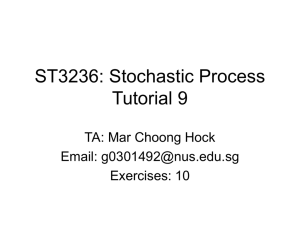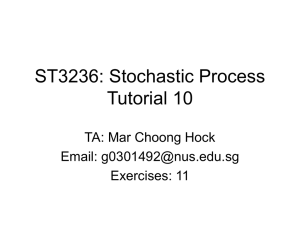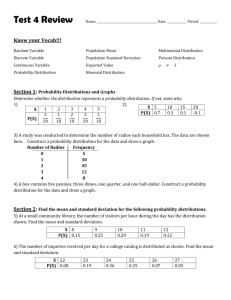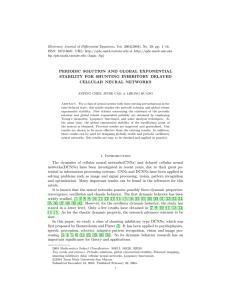PPT
advertisement
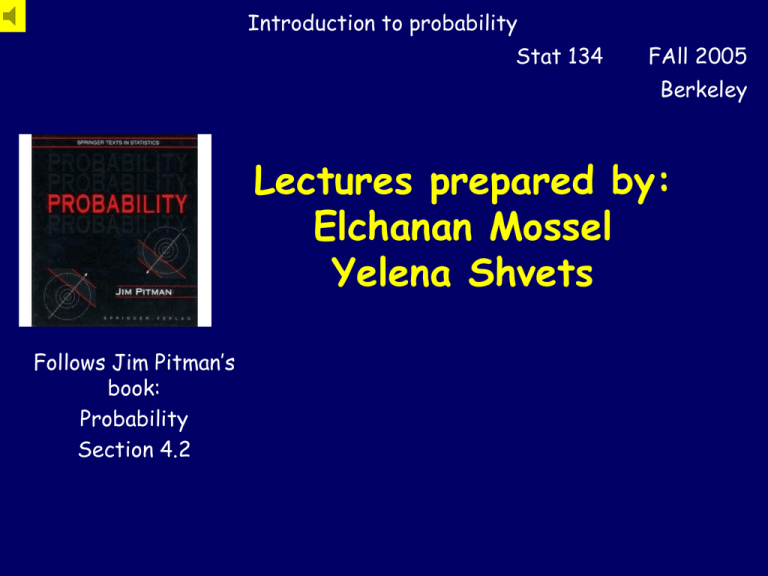
Introduction to probability Stat 134 FAll 2005 Berkeley Lectures prepared by: Elchanan Mossel Yelena Shvets Follows Jim Pitman’s book: Probability Section 4.2 Random Times Random times are often described by a distribution with a density. Examples: •Lifetime of an individual from a given population. •Time until decay of a radioactive atom. •Lifetime of a circuit. •Time until a phone call arrives. Random Times •If T is a random time then its range is [0,). •A random time with the density f(t) satisfies: P(a <T b) =ab f(t)dt . •The probability of surviving past time s is called the Survival Function: P(T>s) = s∞ f(t)dt. •Note that The Survival Function completely characterizes the distribution: P(a <T b) = P(T>a) – P(T>b). Exponential Distribution Definition: A random time T has an Exponential(l) Distribution if it has a probability density f(t)=l e-l t, (t > 0). •Equivalently, for (a b <) P(a<T<b) = sab l e-l t dt= e-l a – e-l b . •Equivalently: P(T>t) = e-l t, (t > 0). Claim: If T has Exp(l) distribution then: E(T)=SD(T) = 1/l Exponential densities l= 2.0 f(t)=l e-l t, (t > 0). l = 1.0 l = 1/2 .0 0 1 2 3 4 5 t Memoryless Property Claim: A positive random variable T has the Exp(l) distribution iff T has the memoryless property : P(T>t+s|T>t) = P(T>s) , (t,s > 0) •Proof: If T~ Exp(l), then P(T>t+s |T>t) = P(T>t+s & T>t)/P(T>t) = P(T>t+s)/P(T>t) = e-l( t+s)/e-l t = e-l s = P(T>s) • Conversely, if T has the memoryless property, the survival function G(t)=P(T>t) must solve G(t+s) = G(t)G(s) . •Thus L(t) = log G(t) satisfies L(t+s) = L(t) + L(s) and L is decreasing. •This implies L(T) = -l t or G(t) = e-l t Memoryless Property Mr. D. is expecting a phone call. Given that up to the time t minutes the call hasn’t come, the chance that the phone call will not arrive in the next s min. is the same as the chance that it hasn’t come in the first s min. P(T>t+s|T>t) = P(T>s), (t,s ¸ 0). Hazard Rate The constant parameter l can be interpreted as the instantaneous death rate or hazard rate: P(T t + D| T > t) = 1 - P(T > t + D| T > t ) = 1 – P(T > D), by the memoryless property = 1 – e-lD = 1 – [1 - l D + ½ (l D)2 - …] lD The approximation holds if D is small (so we can neglect higher order terms). Claim: Exponential & Geometric Distributions Suppose G(p) has a geometric p distribution, then for all t and l: limp 0 P(pG(p)/l > t) = e-l t. Proof: • limp -> 0 P(p G(p)/l>t) = limp -> 0 P(G(p)> l t/p) = limp -> 0 (1-p) l t/p = limp -> 0 (1-p) l t/p = e- l t . Relationship to the Poisson Process Let the unit interval be subdivided into n cells of length 1/n each occupied with probability p = l /n. 0 Note that the number of occupied cells is Bin(n,l/n). 1 Relationship to the Poisson Process Question: What’s the distribution of the successes in an interval (s,t)? t s W2= 3*1/n W3=2/n W4= 1/n W5= 2/n W6= 3/n W7= 1/n W8= 1/nW9= 1/n Number of successes in (t-s) n trials is distributed as Bin((t-s) n,l/n) Poisson((t-s)l). Question: What is the distribution of Wi’s, the waiting times between success i-1 and success i. Time = (# of empty cells+1)* 1/n ~ ~ Geom(l /n)*1/n exp(l). Two descriptions of Poisson Arrival Process 1. Counts of arrivals: • The Number of arrivals in a fixed time interval of length t is a Poisson(lt) random variable: • P(N(t) = k) = e- lt (lt)-k/k! • # of arrivals on disjoint intervals are independent. 2. Times between successes: • Waiting times Wi between successes are Exp(l) random variables: P(Wi>t) = e-l t • The random variables Wi are independent. Poisson Arrival Process •Suppose phone calls are coming into a telephone exchange at an average rate of l= 3 per minute. •So the number of calls N(s,t) between the minutes s and t satisfies: N(s,t) ~ Poisson(3(t-s)). •The waiting time between the (i-1)st and the ith calls satisfies: Wi ~ Exp(3). Question: What’s the probability that no call arrives between t=0 and t=2? Solution: N(0,2) ~ Poisson(6), P(N(0,2) = 0 ) = e-6 =0.0025. Poisson Arrival Process Suppose phone calls are coming into a telephone exchange at an average rate of l= 3 per minute. So for the number of calls between the minutes s and t, we have: N(s,t) ~ Poisson(3(t-s)). For the waiting time between the (i-1)st and the ith calls, we have: Wi ~ Exp(3). Question: What’s the probability that the first call after t=0 takes more than 2 minute to arrive? Solution: W1 ~ Exp(3), P(W1 2 ) = e-3*2 =0.0025. Note: the answer is the same as in the first question. Poisson Arrival Process Suppose phone calls are coming into a telephone exchange at an average rate of l= 3 per minute. So for the number of calls between the minutes s and t, we have: N(s,t) ~ Poisson(3(t-s)). For the waiting time between the (i-1)st and the ith calls, we have: Wi ~ Exp(3). Question: What’s the probability that no call arrives between t=0 and t=2 and at most 4 calls arrive between t=2 and t=3 ? Solution: By independence of N(0,2) and N(2,3), this is P(N(0,2) = 0) * P(N(2,3) 4) = e-6 e-3 (1 + 3 + 32/2! + 33/3! + 34/4!) =0.0020, Poisson Arrival Process Suppose phone calls are coming into a telephone exchange at an average rate of l= 3 per minute. So for the number of calls between the minutes s and t, we have: N(s,t) ~ Poisson(3(t-s)). For the waiting time between the (i-1)st and the ith calls, we have: Wi ~ Exp(3). Question: What’s the probability that the fourth call arrives within 30 seconds of the third? Solution: P(W4 0.5) = 1 – P(W4 > 0.5) = 1 - e-3/2 =0.7769. Poisson Arrival Process Suppose phone calls are coming into a telephone exchange at an average rate of l= 3 per minute. So for the number of calls between the minutes s and t, we have: N(s,t) ~ Poisson(3(t-s)). For the waiting time between the (i-1)st and the ith calls, we have: Wi ~ Exp(3). Question: What’s the probability that the fifth call takes more than 2 minutes to arrive? Solution: P(W1 + W2 + W3 + W4 + W5 > 2) = P(N(0,2) 4) P(N(0,2) 4) = e-6 (1 + 6 + 62/2! + 63/3! + 64/4!) =0.2851. Poisson rth Arrival Times •Let Tr denote the time of the rth arrival in a Poisson process with intensity l. The distribution of Tr is called Gamma(r,l) distribution. • Note that: Tr= W1 + W2 + … + Wr, are the waiting times between arrivals. where Wi’s •Density: P(Tr (t,t+dt))/dt = P[N(0,t) = r-1] * (Rate); •Right tail probability: P(Tr > dt) = P(N(0,t) r-1); •Mean and SD: Gamma Densities for r=1 to 10. Probability density in multiples of l. 1.0 Due to the central limit theorem, the gamma(r,l) distribution becomes asymptotically normal as r . 0.0 0 5 10 15 20 Time in multiples of 1/l. 25 Relationship between Poisson and Exponential. Property/idea Discrete Continuous Wait time until one success Geometric (p) (trials) Exponential (λ) (time) Number of successes in a fixed interval Binomial (n, p) (fixed trials n) Poisson (λt) (fixed time t) Wait time until k successes NegBin (k, λ) Gamma (k, λ) P(kth success/hit is after some time) NegBin (k, λ) > n Gamma (k, λ) > t P(less than k successes in some time) Binomial (n, p) ≤ k-1 Poisson (λt) ≤ k-1


